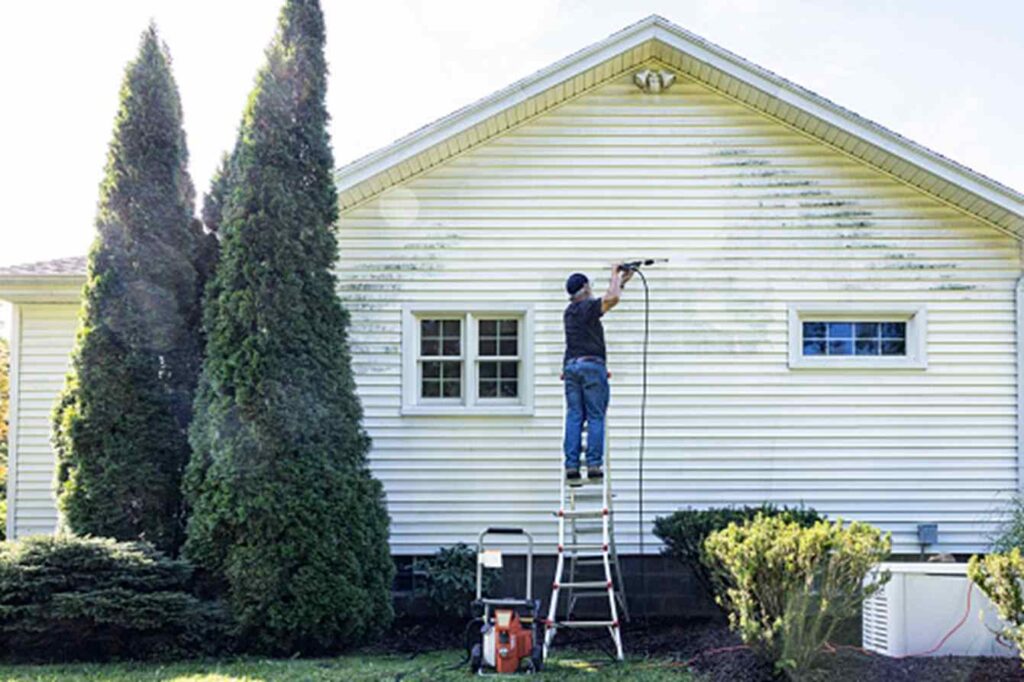
If you’re planning to clean your home’s exterior, you may have heard the terms power washing and soft washing tossed around. While they sound similar, these two methods are quite different — and choosing the wrong one could mean damaging your property instead of restoring its beauty. 😬
So which one should you use? The answer depends on the surface you’re cleaning, the type of grime you’re removing, and the materials involved. In this article, we’ll break down the key differences, pros and cons, and best use cases for both techniques — so you can make the smartest, safest decision for your home. 🧼
💧 What Is Power Washing?
Power washing (also known as pressure washing) uses a high-pressure stream of water — often at 1,500 to 4,000 PSI — to blast away dirt, mold, mildew, oil, and more.
Best for:
- Concrete driveways and sidewalks
- Brick walls
- Stone patios
- Heavy grease or oil stains
- Decks (with caution)
💥 Think of power washing as the “muscle” of outdoor cleaning. It’s aggressive and extremely effective on tough surfaces.
Browse Amazon Here For Top Rated Power Washers And Accessories
🧴 What Is Soft Washing?
Soft washing uses low pressure combined with cleaning solutions to safely remove dirt, mold, algae, and mildew. The pressure typically stays under 500 PSI — more like a strong garden hose than a blasting jet. 🌿
Best for:
- Vinyl or wood siding
- Roof shingles
- Stucco
- Painted surfaces
- Fences
Soft washing relies on chemistry, not force. The detergents do most of the heavy lifting by breaking down grime, which is then rinsed away gently.
Browse Amazon Here For Soft Washing Equipment And Accessories
⚖️ Side-by-Side Comparison
| Feature | Power Washing 💥 | Soft Washing 🧴 |
|---|---|---|
| Pressure Level | High (1,500–4,000+ PSI) | Low (<500 PSI) |
| Cleaning Agent | Optional | Required (detergents/chemicals) |
| Best For | Concrete, brick, stone | Siding, roofs, soft materials |
| Risk of Damage | High if used improperly | Low when done correctly |
| Removes Mold/Algae | Yes (physically) | Yes (chemically kills spores) |
| Surface Lifespan | Can shorten if overused | Gentle on surfaces |
🧱 When to Use Power Washing
✅ Go with power washing when you need to:
- Strip away tough grime, oil, or dirt from hard surfaces
- Remove peeling paint before repainting
- Prep driveways, patios, or walkways for sealing
- Clean commercial concrete or parking lots
❌ Avoid power washing:
- Roof shingles
- Painted wood
- Stucco
- Windows or thin screens
💡 Even for wood decks and fences, use lower PSI and fan tips to prevent splintering.
🌸 When to Use Soft Washing
Soft washing is your best friend when dealing with delicate surfaces or areas that require mold and mildew treatment.
✅ Use soft washing for:
- Cleaning vinyl or wood siding
- Washing asphalt shingles (kills algae)
- Removing mold from fences, screens, and sheds
- HOA properties with strict surface rules
- Outdoor furniture and decorative surfaces
Soft washing is often the only method recommended for roof cleaning — it kills moss and algae at the root without harming shingles. 🌿
🧪 The Role of Chemicals in Soft Washing
Unlike pressure washing, which relies on brute force, soft washing requires the right mix of:
- Detergents to lift dirt
- Algaecides or fungicides to kill growth
- Surfactants to help solutions cling and penetrate
These cleaners are usually biodegradable and safe for plants when diluted properly. 🌱
A professional soft wash uses controlled chemistry, dwell time, and gentle rinsing — no blasting needed.
🛡️ Which Is Safer for Your Home?
For most homeowners, soft washing is the safer option unless you’re dealing with concrete, brick, or industrial messes.
Power washing can:
- Strip paint
- Gouge wood
- Damage shingles or seals
- Force water into gaps or under siding
Even a small mistake can lead to mold behind walls or costly repairs.
✅ Soft washing is less risky and more forgiving — especially for DIYers.
🧰 Should You DIY or Hire a Pro?
If you’re confident with tools and follow directions, you may be able to safely power wash certain areas like your driveway or deck.
However, for soft washing or tricky surfaces (like roofs or second stories), it’s smart to hire a licensed pro who understands:
- Chemical mixing and dwell times
- Water pressure settings
- Runoff control and safety protocols
👷♂️ A pro can clean more thoroughly, safely, and quickly — and it may cost less than fixing damage later.
💡 Pro Tip: Combine Both Methods
Many professional companies use both techniques, depending on the area:
- Power wash driveways and patios
- Soft wash siding, roofs, and fencing
The key is knowing which method to use — and when. That’s what separates amateurs from experienced cleaners.
🧽 Final Thoughts
Both power washing and soft washing are incredible tools — when used correctly. The best choice for your home depends on:
- The surface you’re cleaning
- The type of grime involved
- Your comfort level with the equipment
Choose power washing when you need muscle, and soft washing when you need finesse.
No matter which method you go with, remember: cleaning the outside of your home helps protect your investment — and makes it look great too. 🏠✨
Browse Amazon Here For Soft Washing Equipment And Accessories



